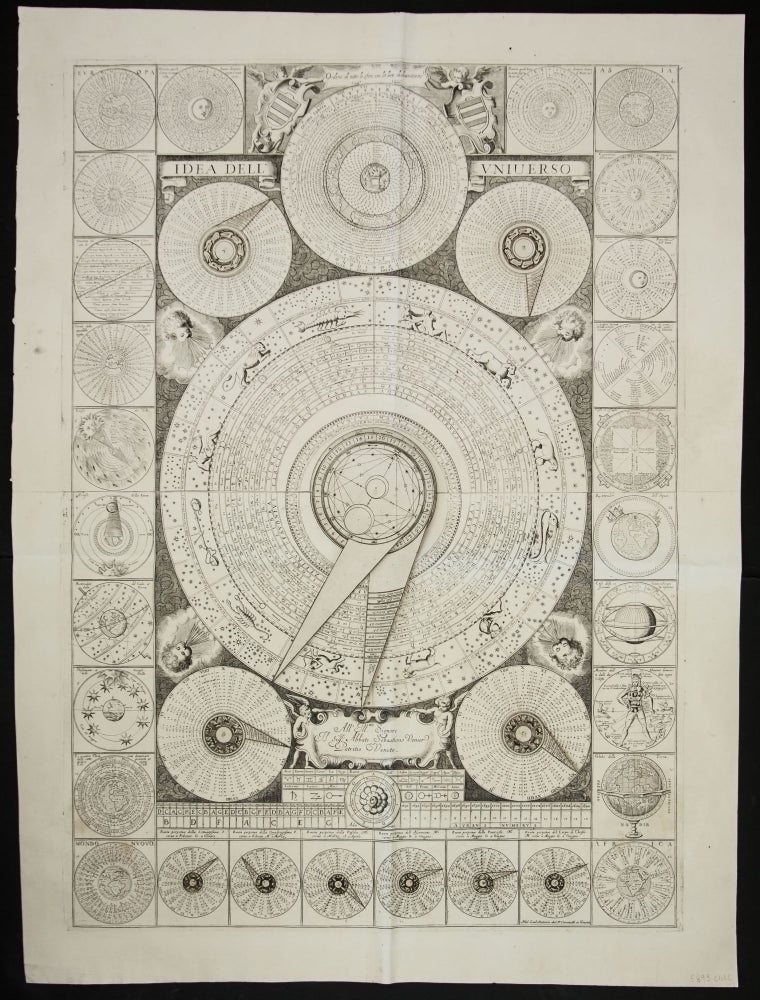
Idea dell’ Universo.
Venice, Coronelli, [1691]. 2 imperial folio sheets [77.1 x 55.0 cm the platemark; 86.4 x 64.1 x cm the sheet], (2) engraved sheets joined, complete with (12) volvelle pointers attached with knotted string. Fine dark strikes on thick paper, unobtrusive centerfold, an excellent example of this engraving. Rare first edition of Vincenzo Coronelli’s extraordinary Idea dell’ Universo, an enormous 2-sheet (some 2.5 x 1.75 feet) cosmological chart which is among the most extensive and painstaking (as well as visually striking) efforts to depict a huge quantity of information about the world ever published in a single visual presentation. The present example is notable for preserving its 12 volvelle parts, which whether mounted (as here) or separately on an uncut sheet, are especially rare: We have encountered just two copies of this print preserving the volvelles (Getty, Yale) and those are second editions of the plate bound in Coronelli’s later Cronologia Universale (1707). Coronelli’s meticulous Idea dell’ Universo both “can be used as a lens through which to consider the preceding two centuries and more of the diagrammatic traditions of astronomy and cosmography” (Mosley, p. 27) and can be seen as a daringly modern experiment in what the theorist Edward Tufte (b. 1942) would later term cutting-edge ‘information design’ or ‘data visualization.’ The Idea dell’ Universo has at its center a large wheel diagram with two rotating pointers which presents complex astrological information (an aspectarium, calendar ring with months and a degree scale, twelve winds, twelve zodiac, signs, fortune degrees, planetary rulers, etc., etc.). While this information is derived from Apian, Maurolyco, Barozzi, Cellarius, and others, its presentation in a single figure is “entirely the result of Coronelli’s own work” (Mosely, p. 41). Above this central instrument is a figure of nested spheres centered on a Dantean Inferno that radiates out through the terraqueous earth, the planets, and into the empyrean. Four circles flanking the central instrument are used to calculate the hour and minute of sunrise and of midday and the day, hour and minute of both the new and full moon. In the border at the foot of the sheet are six wheels for calculating moveable feasts, while in the top and side borders are 22 numbered diagrams which include maps of Europe, Asia, Africa, and the New World, global climates, planetary rulers for those born at night and in the day, lunar mansions, diagrams of solar and lunar eclipse, relations between alchemical spiriti, the ebb and flow of waters, the winds, a zodiac man, etc. (see Mosley for a full description). Coronelli included the Idea dell’ Universo in the Atalante Veneto (1691), his first major publication, and in more deluxe copies of the Corso Geografico (1692), but the chart was designed to stand alone (“at no point in the text is the purpose of these figures explained” [Mosley, p. 43]) and so was likely also available for purchase separately. The chart’s imprint at the bottom right reads, “Nel Laboratorio de P. Cornelli in Venezia.” At the bottom center is a cartouche flanked by putti with a dedication to Abbate Sebastiano Venier. Venier’s name has been erased and the cartouche left blank in the second edition of the plate, which appeared in Coronelli’s Cronologia Universale (1707) * E. Armao, Vincenzo Coronelli, p. 198-9, no. 104; A. Mosley, “Vincenzo Maria Coronelli’s Atalante Veneto and the Diagrammatic Tradition of Cosmography,” Journal for the History of Astronomy, vol. 41, no. 1 (2011), pp. 27-53.
Sold
